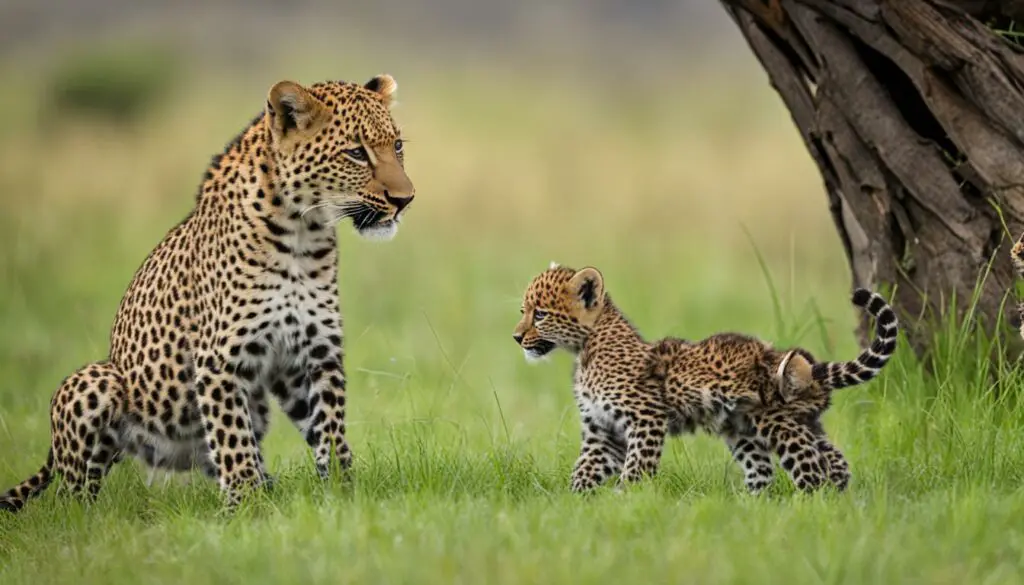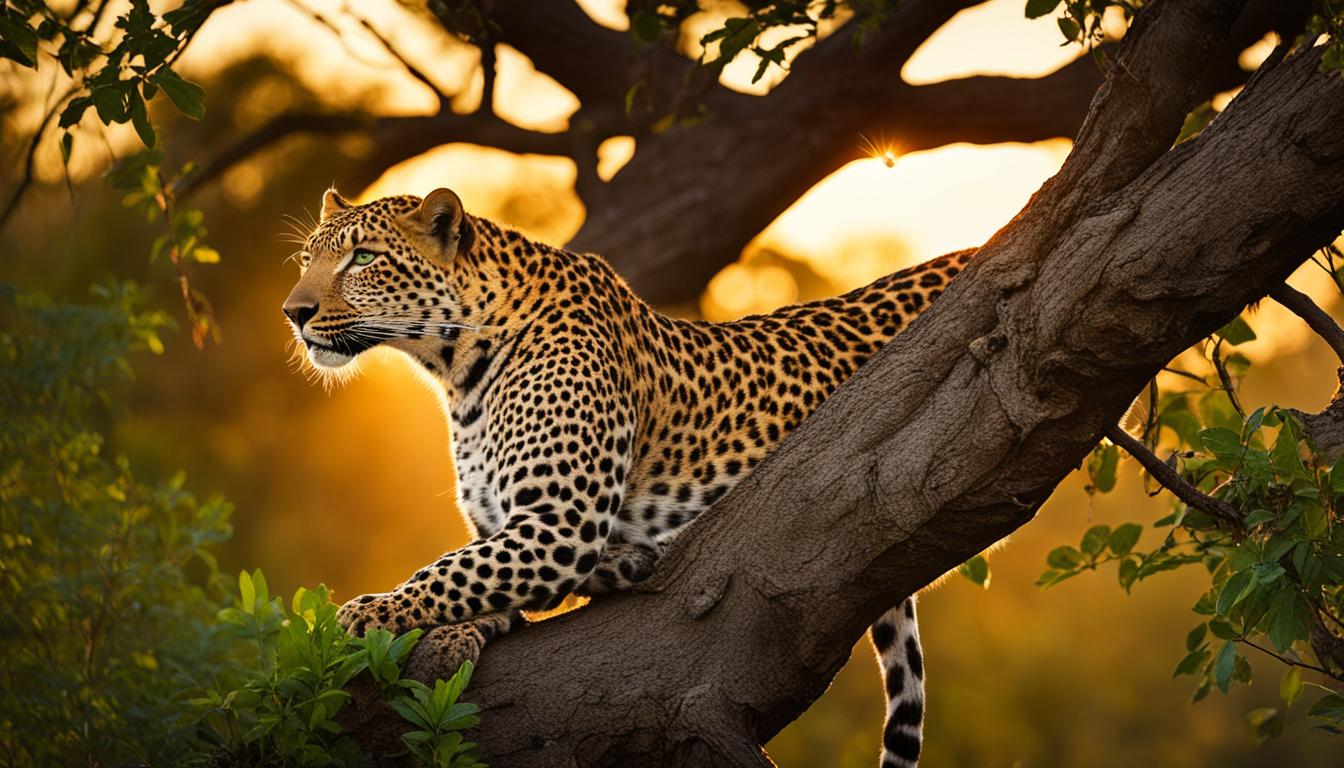Welcome to our article on leopard behavior and habitat! In this section, we will explore how leopards establish and defend their territories. Understanding leopard territory is crucial for conserving their population and protecting their habitats. So, let’s dive into the fascinating world of these solitary and majestic creatures.
Leopard Habitat and Range
Leopards are incredibly adaptable creatures, capable of thriving in a variety of habitats. They can be found in forests, grasslands, mountains, and even plantations. Their wide distribution spans over 80 countries across Africa, the Middle East, Far East, and parts of Siberia.
Within South Africa, leopards have a significant presence, with the exception of the Greater Karoo basin. Their habitats range from lush rainforests to arid deserts, showcasing their remarkable ability to adapt to diverse environments. In desert regions, leopards are typically restricted to moist water courses.
However, human encroachment has led to an increasing number of leopard sightings in urbanized landscapes. As these majestic creatures continue to contend with shrinking habitats, leopard conservation efforts have become crucial in protecting their homes and ensuring their survival.
Table: Distribution of Leopards in Different Regions
| Region | Habitat | Range |
|---|---|---|
| Africa | Various habitats including forests, grasslands, and mountains | Widespread across the continent |
| Middle East | Mainly mountains and arid regions | Scattered populations |
| Far East | Forests and mountains | Found in countries such as India, Nepal, and China |
| Siberia | Taiga and mountainous regions | Restricted range in southern Siberia |
In conclusion, leopards are incredibly versatile when it comes to their habitat preferences. They have adapted to a wide range of environments and can be found in various regions around the world. However, the encroachment of human activities poses a threat to their survival, making leopard conservation efforts all the more important.
Leopard Behavior and Communication
Leopards are fascinating creatures with unique behaviors and ways of communicating. They are solitary and secretive carnivores, perfectly adapted for hunting. With their stocky muscular bodies, short powerful legs, and sharp canines, leopards are skilled predators in their natural habitat.
Leopards have distinctive coats that change as they grow. Cubs have barely visible spots, while adults display a stunning yellow or golden undercoat with black rosettes and spots. These markings help camouflage them in their surroundings.
Communication is crucial for leopards to establish their presence, mark their territories, and find potential mates. Scent marking is a primary form of communication for leopards. They use urine, anal sac secretions, and cheek rubbing on objects to leave their scent and convey their territory boundaries. Additionally, leopards may use claw marks on tree trunks and scrape markings on the ground to leave their mark.
Vocal cues also play a significant role in leopard communication. They use sawing, coughing, rasping, and roaring to communicate with their counterparts. Visual cues, such as tail flicking and body postures, are also essential in their communication with other leopards.
Leopard cubs learn survival skills and communication techniques from their mothers. Soft sounds like grunts and mews are used by cubs to communicate with their mothers and siblings. Leopards also have a keen sense of smell and use the flehmen response to register scents from the environment.
In conclusion, the behavior and communication of leopards are fascinating aspects of their ecology. From scent marking to vocal and visual cues, leopards have developed unique ways to interact with their surroundings and other members of their species.
The Life Cycle of Leopards

Leopards have a fascinating life cycle that involves various stages of development and reproduction. Understanding their life cycle is crucial for studying and conserving these magnificent animals. Let’s explore the different phases of a leopard’s life.
1. Sexual Maturity and Mating:
Male leopards typically reach sexual maturity between two-and-a-half to four years old, while females mature around two-and-a-half to three years old. Male leopards are polygamous, mating with multiple females. Female leopards indicate their readiness for mating through various behaviors and pheromones, attracting males to initiate the mating process.
2. Birth and Cub Rearing:
After a gestation period of approximately 100 days, female leopards give birth to a litter of cubs. The cubs are born blind and open their eyes after four to nine days. They rely on their mother’s milk for sustenance during the first four months of their lives. At around eight months old, the cubs start practicing their hunting skills under their mother’s guidance. Female leopards raise the cubs alone and protect them until they reach independence around 12 months old.
3. Independence and Territorial Establishment:
Once the cubs gain independence, they leave their mother’s territory and venture out to find their own territories. This ensures genetic diversity and reduces competition within the same area. Male leopards have larger territories than females and tend to overlap territories without hostility. Leopards mark their territories using scent, vocalization, and visual cues, ensuring clear communication with other leopards and minimizing territorial confrontations.
| Sexual Maturity | Mating | Birth and Cub Rearing | Independence and Territorial Establishment |
|---|---|---|---|
| Male: 2.5-4 years old Female: 2.5-3 years old |
Polygamous mating with multiple females | Gestation period: approximately 100 days Cubs born blind, eyes open after 4-9 days Mother’s milk for 4 months Start hunting practice at 8 months Independence at 12 months |
Cubs leave mother’s territory Males move away from natal area Females tend to remain near mother’s territory Males have larger territories, overlapping with females Territory marking through scent, vocalization, and visual cues |
Understanding the life cycle of leopards provides valuable insights into their behavior, reproduction, and population dynamics. It highlights the importance of protecting their habitats and ensuring the survival of these iconic big cats for future generations to enjoy.
Conclusion
In conclusion, leopards are fascinating creatures with unique territorial behaviors and communication methods. Their territories are established based on the availability of prey and suitable den sites for females, while males prioritize territories with multiple females for mating. The boundaries of these territories may change as new leopards arrive and others fade away, ensuring genetic diversity within the population.
Leopards are adaptable to various habitats, ranging from forests to deserts, and can even be found in urbanized landscapes due to human encroachment. Unfortunately, their populations are declining and becoming fragmented outside of sub-Saharan Africa, making leopard conservation efforts crucial for their survival.
Leopards communicate through scent marking, vocal cues, and visual cues, ensuring effective communication within their territories. Cubs learn survival skills and communication from their mothers, fostering their independence after 12 months. As they grow, male leopards will move away from their natal areas, while females tend to remain near their mother’s territory.
In summary, understanding the behavior, habitat, and lifecycle of leopards is crucial for their conservation. By protecting their habitats and implementing effective conservation strategies, we can ensure a future where these majestic creatures continue to roam and thrive in the wild.
Do Leopards Use Their Territory to Communicate with Each Other?
Leopards use their territory as a way to communicate with each other through various leopards wild communication methods. Scent marking, vocalizations, and visual displays within their territory help leopards establish and maintain their presence and boundaries, allowing them to communicate effectively with other leopards in the area.
FAQ
How do leopards establish and defend their territories?
Leopards establish territories based on the abundance of prey species and water availability. They use scent marking, vocal cues, and visual cues to communicate with other leopards and defend their territories.
What is the habitat and range of leopards?
Leopards occur in various habitats, including forests, grasslands, mountains, and even plantations. They have a wide distribution, found in over 80 countries across Africa, the Middle East, Far East, and parts of Siberia. In South Africa, leopards are found throughout, except in the Greater Karoo basin. Their habitats range from rainforests to deserts, adapting to different environments.
How do leopards communicate with each other?
Leopards communicate their presence, territory, and availability to mate through various methods. They use scent marking, vocal cues, and visual cues like tail flicking and body postures. Cubs learn survival skills and communication from their mothers, using soft sounds like grunts and mews.
What is the life cycle of leopards?
Female leopards give birth to cubs after a gestation period of 100 days. Cubs are born blind and open their eyes after four to nine days. They drink milk from their mother for four months and start practicing their own kills at eight months. Female leopards raise the cubs alone and protect them until they reach independence around 12 months old.










